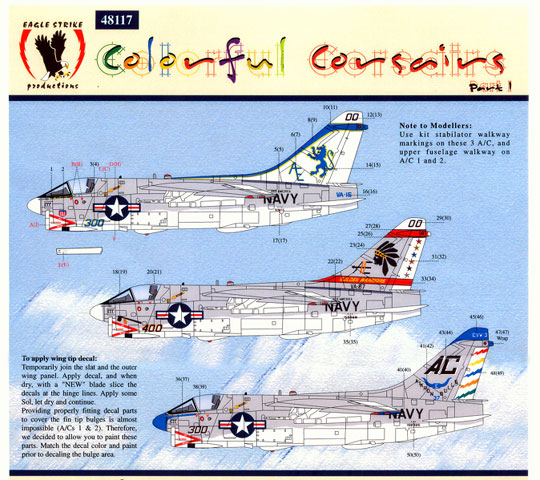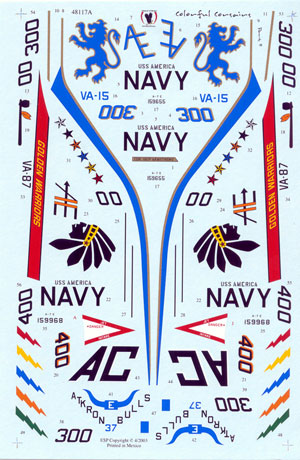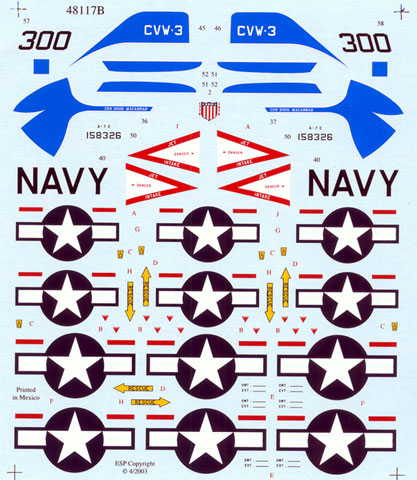|
Colorful
Corsairs
Part I
A-7 Corsair

Eagle Strike
Decals
|
|
|
S u m m a r y
|
| Catalogue
Number: |
Eagle Strike 48-117 -
Colorful Corsairs Part 1 |
| Scale: |
1/48 |
| Contents and Media: |
Waterslide decals - Decal
sheet plus instructions and notes |
| Price: |
MSRP USD$10
available from Aeromaster's website |
| Review Type: |
FirstLook |
| Advantages: |
Perfect register; thin;
minimal carrier film; good instructions and background; all
markings for all aircraft included; errata sheet corrects a
problem |
| Disadvantages: |
|
| Recommendation: |
|
Reviewed
by Rodger Kelly

Aeromaster Decals' 1/48 scale Colorful Corsairs
will be available
online from Squadron.com
Sheet number 48117 is the
first part in two-part coverage of the A-7 Corsair II by Eagle Strike
Productions.
These markings hark back to the
time when it wasn't just the CAG and CO's aircraft that wore colourful
markings in a US Navy attack squadron.
Markings are provided for three
A-7E CAG aircraft of the Atlantic Fleet.
 Bureau
number 159655, of VA-15 'Valions'. The markings depict the
aircraft whilst it was at Marine Corps Air Station Yuma, Arizona in
January 1977. Finish is gull grey and white with a white vertical
stabilizer and nose. Markings include: Bureau
number 159655, of VA-15 'Valions'. The markings depict the
aircraft whilst it was at Marine Corps Air Station Yuma, Arizona in
January 1977. Finish is gull grey and white with a white vertical
stabilizer and nose. Markings include:
-
A red, white and blue
Bi-Centennial shield for the forward fuselage.
-
A black outlined gold
block with the pilot's name in black lettering for forward fuselage
below the windscreen.
-
Unit markings that
consist of gold outlined blue trim that cover the top of the spine on
the fuselage, the leading edge of the fin and the antenna fairing on the
top of the fin. These markings are supplied in four parts – left and
right hand side and separate but smaller gold edging to go underneath
the antenna fairing. There is no decal to cover the antenna fairing. A
note on the placement sheet advises that "providing properly fitting
decals to cover the fin tip bulges is almost impossible, therefore, we
decided to allow you to paint these parts. Match the decal colour and
paint prior to decaling the bulge area." Fair enough, but I would have
liked to have had a block of decal in the same colour to at least have a
go – settling solution is a wonderful thing!
-
VA-15 squadron insignia
consisting of a rampant lion in blue and gold.
-
USS America titles and
Bureau number block in black for the rear fuselage.
-
VA-15 titles in blue for
the tail cone.
-
300 Modex. Blue with a
gold outline for the fuselage with abbreviated '00's in black for the
fin cap and a further pair of 300s for the top of the flaps.
-
Blue with gold
'shadowing AE airwing identifier for the vertical stabilizer.
Bureau number 159968, of VA-87 'Golden
Warriors'. The markings depict it as it appeared in January of
1977. Finish is gull grey and white with a white radome and fin cap. The
supplied markings comprise:
-
The 'Golden Warriors'
tomahawk marking with orange feathers for the nose - (the colour orange
is used for the 4th squadron in the US Navy marking system).
-
400 modex. Black with
orange 'shadowing' for the nose with abbreviated '00's in black for the
fin cap and a further pair of 400s for the top of the flaps.
-
A squadron marking
consisting of a black edged red band with 'Golden Warriors' tiles
in yellow lettering for the base of the vertical stabilizer and rudder.
-
Thin black stripes to
act as an edge to the red stripe that you will have to paint across the
top of the vertical stabilizer. Again, I would have liked to have seen
an oversized block of decal in the same colour as the above marking so I
could at least have ago at applying it to save having to try and match
the red of the other decal. Not a criticism, just a preference.
-
Stylized AE airwing
identifier in orange and black with an arrow forming the cross bars of
each letter for the vertical stabilizer.
-
Squadron insignia for
the vertical stabilizer featuring a profile of an Indian's head wearing
a war bonnet in black with the base of the war bonnet in yellow with a
red star.
-
Stars in each colour of
the squadron within the air group for the rudder.
-
VA-87 titles for the
base of the vertical stabilizer.
-
USS America titles and
Bureau number block in black for the rear fuselage.
Bureau number 158326, of VA-37
'Bulls'. The markings depict it as it appeared in August of
1973. Finish is gull grey and white with blue trim on the leading edge of
the fin and fin cap, wing tips, nose radome and the rear of the tail
mounted antenna. The supplied markings consist of:
-
The blue trim for the
nose radome. This is a two piece decal – left and right hand sides –
and it includes thin white edging. The decal includes the bar that
extends back beneath the windscreen and incorporates the pilot's name in
white lettering.
-
300 modex in black with
white shadowing for the nose with a further plain black pair for the
flaps.
-
Black with white
shadowing AC airwing identifier for the vertical stabilizer.
-
A squadron marking, for
the base of the vertical stabilizer, consisting of a bull's horns in
blue with a white battle E in their centre, the words ATKRON 37 BULLS.
The words are in black with the 37 in blue with white shadowing.
-
The blue fin leading
edge and fin cap marking with CVW-3 titles in white. This is a two
piece marking – left and right hand sides - and it incorporates a thin
white band to the bottom edge.
-
Five lightning bolts for
the rudder, each in a different colour representing each squadron within
the air group.
-
Bureau number block in
black for the rear fuselage.
-
The blue trim for the
wing tips. Supplied as top and bottom with a thin white inboard edge.
The placement guide advises you to temporarily join the slat to the
outer wing and apply the decal and, when dry, slice the decal where the
slat joins wing with a new blade.
-
The blue trim to wrap
around the rear of the fin mounted antenna.
 Each
option has its own set of national insignia, NAVY titles, intake warnings
and basic stencilling. The stencilling is mainly confined to the larger,
more visible data such as the rescue arrows, rescue information and
ejection seat triangles. Three separate sheets are included. The larger
one contains the minority of individual markings and the second, smaller
sheet carries the blue trim for the VA-37 option, a set of NAVY titles and
all of the national insignia and stencil data. The last one is an errata
sheet and it carries a replacement set of VA-15 blue and gold markings as
the ones on the main sheet are too light. Each
option has its own set of national insignia, NAVY titles, intake warnings
and basic stencilling. The stencilling is mainly confined to the larger,
more visible data such as the rescue arrows, rescue information and
ejection seat triangles. Three separate sheets are included. The larger
one contains the minority of individual markings and the second, smaller
sheet carries the blue trim for the VA-37 option, a set of NAVY titles and
all of the national insignia and stencil data. The last one is an errata
sheet and it carries a replacement set of VA-15 blue and gold markings as
the ones on the main sheet are too light.
You can build every option on the
sheet without looking elsewhere – it's all there.
The decals have been 'printed in
Mexico', and a nice job of printing it is too! Everything is in perfect
register even the difficult white 'shadowing' on the small 37s on the
VA-37 tail marking. The decals are glossy and there is an absolute
minimum of carrier film surrounding each subject.
The placement sheet is A-4 in size
and in full-colour. It shows left hand side profiles of each option, a
close-up of the nose of a generic A-7 (to show where the stencil data
goes) and a smaller generic top view. There is a smaller black and white
placement sheet provided as well. This is an errata sheet that carries
the correct numbers for the modex numbers on the tops of the flaps. The
rear of the placement sheet also has a comprehensive guide to applying
decals.
The decals, placement guide and
errata sheet are packed in a clear plastic zip-loc bag.

The recommended kit is the
Hasegawa one.
A very nice sheet from
Eagle Strike.
It is good to see that Eagle
Strike have gone the extra length and replaced the blue squadron markings
for the VA-15 option as well as supplying an errata sheet for the
placement guide. This and the fact that all of the markings are supplied
for all of the options make it great value for money
Recommended.
Thanks to AeroMaster
/ Eagle Strike
Products for the review sets
On-line sales are available from the
AeroMaster Products /
Eagle Strike Productions web site.
Review TextCopyright © 2003 by
Rodger Kelly
This Page Created on 30 October, 2003
Last updated
30 October, 2003
Back to
HyperScale Main Page |
Home | What's
New | Features
| Gallery |
Reviews | Reference
| Forum
| Search